Financial Accounting: Transactions, Statements, and Principles
VerifiedAdded on 2022/11/28
|26
|4432
|386
Homework Assignment
AI Summary
This financial accounting assignment provides a comprehensive overview of key concepts. It begins with an introduction to financial accounting and its importance, followed by an in-depth analysis of business transactions, single and double-entry systems, and the role of trial balances. The assignment includes detailed journal entries and ledger accounts, culminating in the preparation of a trial balance. It also explores the differences between financial statements and financial reporting, the various users of financial information, and the fundamental accounting principles, including accrual, conservatism, cost, going concern, full disclosure, materiality, and revenue recognition. The assignment then delves into the formulation of financial statements like the profit and loss account, balance sheet, and cash flow statements, with additional focus on bank reconciliation, control, and suspense accounts. The content is presented through detailed scenarios and practical examples to enhance understanding of accounting concepts.

FINANCIAL ACCOUNTING
Paraphrase This Document
Need a fresh take? Get an instant paraphrase of this document with our AI Paraphraser
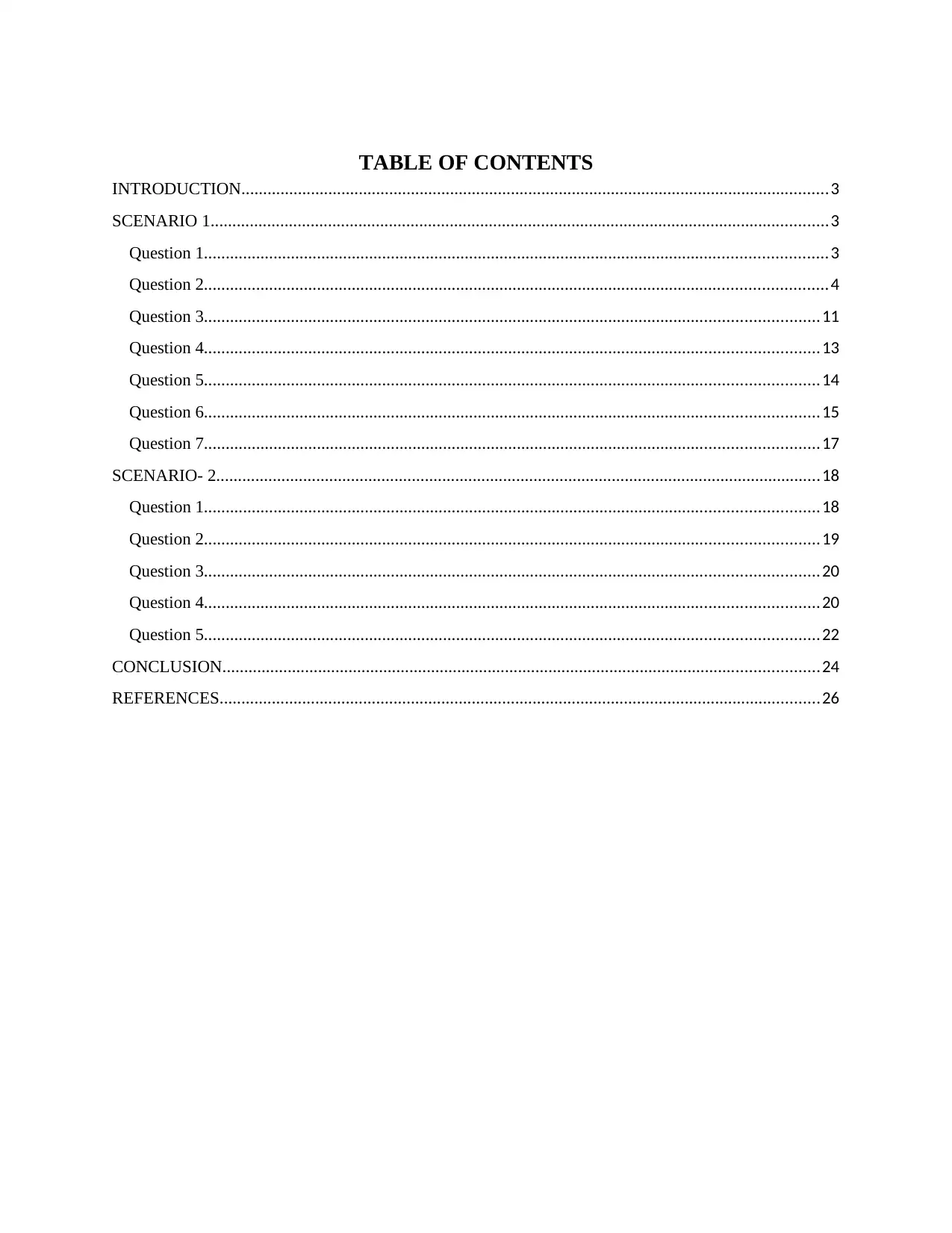
TABLE OF CONTENTS
INTRODUCTION.......................................................................................................................................3
SCENARIO 1..............................................................................................................................................3
Question 1...............................................................................................................................................3
Question 2...............................................................................................................................................4
Question 3.............................................................................................................................................11
Question 4.............................................................................................................................................13
Question 5.............................................................................................................................................14
Question 6.............................................................................................................................................15
Question 7.............................................................................................................................................17
SCENARIO- 2...........................................................................................................................................18
Question 1.............................................................................................................................................18
Question 2.............................................................................................................................................19
Question 3.............................................................................................................................................20
Question 4.............................................................................................................................................20
Question 5.............................................................................................................................................22
CONCLUSION.........................................................................................................................................24
REFERENCES..........................................................................................................................................26
INTRODUCTION.......................................................................................................................................3
SCENARIO 1..............................................................................................................................................3
Question 1...............................................................................................................................................3
Question 2...............................................................................................................................................4
Question 3.............................................................................................................................................11
Question 4.............................................................................................................................................13
Question 5.............................................................................................................................................14
Question 6.............................................................................................................................................15
Question 7.............................................................................................................................................17
SCENARIO- 2...........................................................................................................................................18
Question 1.............................................................................................................................................18
Question 2.............................................................................................................................................19
Question 3.............................................................................................................................................20
Question 4.............................................................................................................................................20
Question 5.............................................................................................................................................22
CONCLUSION.........................................................................................................................................24
REFERENCES..........................................................................................................................................26
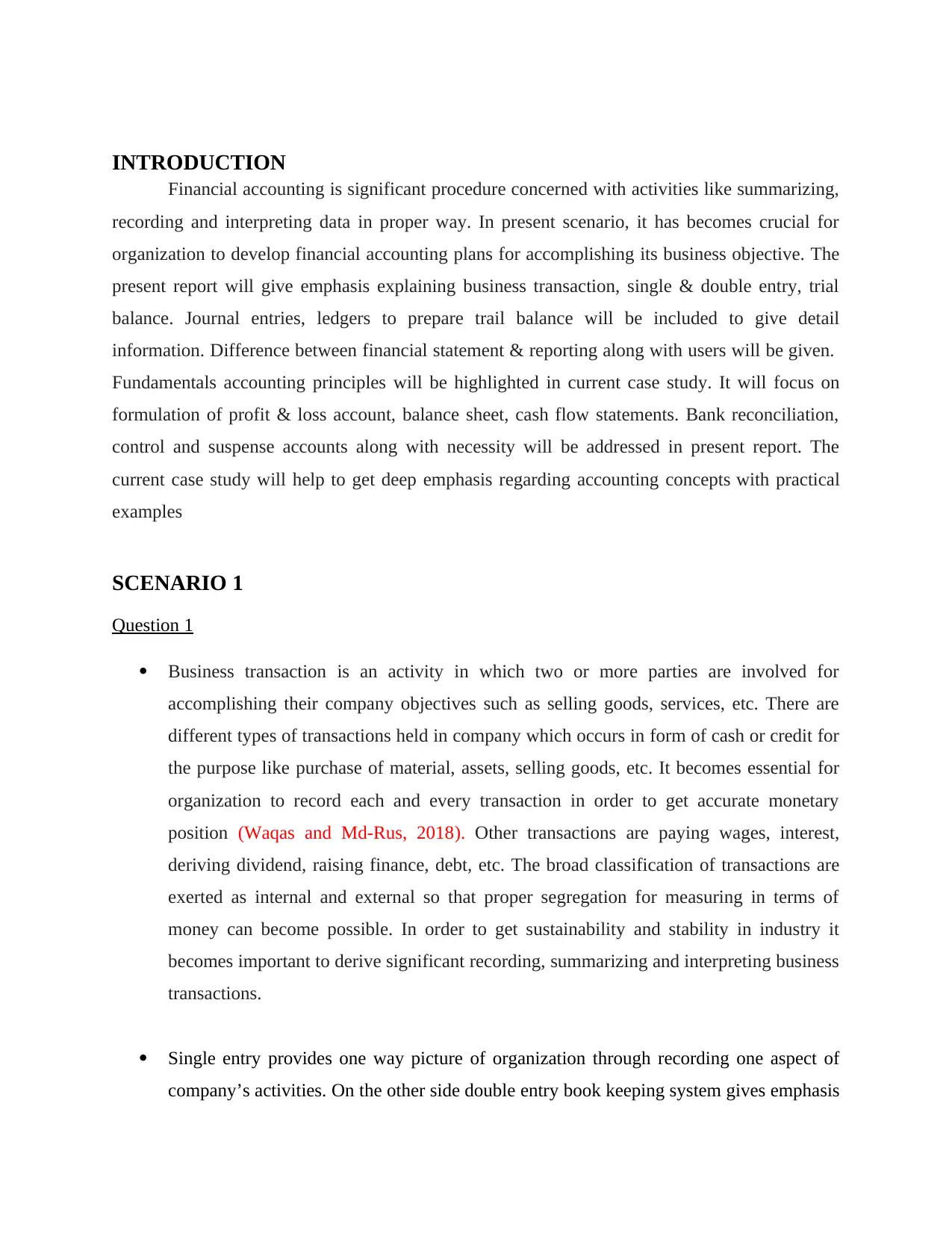
INTRODUCTION
Financial accounting is significant procedure concerned with activities like summarizing,
recording and interpreting data in proper way. In present scenario, it has becomes crucial for
organization to develop financial accounting plans for accomplishing its business objective. The
present report will give emphasis explaining business transaction, single & double entry, trial
balance. Journal entries, ledgers to prepare trail balance will be included to give detail
information. Difference between financial statement & reporting along with users will be given.
Fundamentals accounting principles will be highlighted in current case study. It will focus on
formulation of profit & loss account, balance sheet, cash flow statements. Bank reconciliation,
control and suspense accounts along with necessity will be addressed in present report. The
current case study will help to get deep emphasis regarding accounting concepts with practical
examples
SCENARIO 1
Question 1
Business transaction is an activity in which two or more parties are involved for
accomplishing their company objectives such as selling goods, services, etc. There are
different types of transactions held in company which occurs in form of cash or credit for
the purpose like purchase of material, assets, selling goods, etc. It becomes essential for
organization to record each and every transaction in order to get accurate monetary
position (Waqas and Md-Rus, 2018). Other transactions are paying wages, interest,
deriving dividend, raising finance, debt, etc. The broad classification of transactions are
exerted as internal and external so that proper segregation for measuring in terms of
money can become possible. In order to get sustainability and stability in industry it
becomes important to derive significant recording, summarizing and interpreting business
transactions.
Single entry provides one way picture of organization through recording one aspect of
company’s activities. On the other side double entry book keeping system gives emphasis
Financial accounting is significant procedure concerned with activities like summarizing,
recording and interpreting data in proper way. In present scenario, it has becomes crucial for
organization to develop financial accounting plans for accomplishing its business objective. The
present report will give emphasis explaining business transaction, single & double entry, trial
balance. Journal entries, ledgers to prepare trail balance will be included to give detail
information. Difference between financial statement & reporting along with users will be given.
Fundamentals accounting principles will be highlighted in current case study. It will focus on
formulation of profit & loss account, balance sheet, cash flow statements. Bank reconciliation,
control and suspense accounts along with necessity will be addressed in present report. The
current case study will help to get deep emphasis regarding accounting concepts with practical
examples
SCENARIO 1
Question 1
Business transaction is an activity in which two or more parties are involved for
accomplishing their company objectives such as selling goods, services, etc. There are
different types of transactions held in company which occurs in form of cash or credit for
the purpose like purchase of material, assets, selling goods, etc. It becomes essential for
organization to record each and every transaction in order to get accurate monetary
position (Waqas and Md-Rus, 2018). Other transactions are paying wages, interest,
deriving dividend, raising finance, debt, etc. The broad classification of transactions are
exerted as internal and external so that proper segregation for measuring in terms of
money can become possible. In order to get sustainability and stability in industry it
becomes important to derive significant recording, summarizing and interpreting business
transactions.
Single entry provides one way picture of organization through recording one aspect of
company’s activities. On the other side double entry book keeping system gives emphasis
⊘ This is a preview!⊘
Do you want full access?
Subscribe today to unlock all pages.

Trusted by 1+ million students worldwide

on both sides of business practices to get complete picture. In addition to this, single
entry book keeping is economical but not accurate as all practices are not tracked because
it’s incomplete type of recording mechanism. Evaluation of identifying errors becomes
efficient in double entry as compared to other type. Preparation of financial statements
through giving emphasis on double entry book keeping to ascertained financial position
of organization.
Trail Balance (TB) is utilized as basis for creating financial transaction through
recognizing mistakes for efficient formulation. It is list of all ledgers for ensuring
mathematical accuracy of company’s recording (Blaufus and Hoffmann, 2020). There
are various benefits for outlining TB in company’s accounting procedure which includes
proper estimation of credibility. Fair auditing, implementing adjustments through posting,
ensuring arithmetical accuracy, etc. Trial balance of organization provides assistance in
evaluating financial health in proper manner. all these benefits can be derived through
offsetting errors at initial stage only to save time & other related resources.
Question 2
1. Journal Entries for the month of June 2016
Date Particulars L.F Debit Credit
1-Jun Cash A/C Dr. 65000
To Capital A/C 65000
(Being capital invested for
starting company)
2-Jun Purchase A/C Dr. 8000
To Trade payables A/C 8000
(Being goods purchased on
credit)
7-Jun Cash A/C Dr. 4000
To Sales A/C 4000
entry book keeping is economical but not accurate as all practices are not tracked because
it’s incomplete type of recording mechanism. Evaluation of identifying errors becomes
efficient in double entry as compared to other type. Preparation of financial statements
through giving emphasis on double entry book keeping to ascertained financial position
of organization.
Trail Balance (TB) is utilized as basis for creating financial transaction through
recognizing mistakes for efficient formulation. It is list of all ledgers for ensuring
mathematical accuracy of company’s recording (Blaufus and Hoffmann, 2020). There
are various benefits for outlining TB in company’s accounting procedure which includes
proper estimation of credibility. Fair auditing, implementing adjustments through posting,
ensuring arithmetical accuracy, etc. Trial balance of organization provides assistance in
evaluating financial health in proper manner. all these benefits can be derived through
offsetting errors at initial stage only to save time & other related resources.
Question 2
1. Journal Entries for the month of June 2016
Date Particulars L.F Debit Credit
1-Jun Cash A/C Dr. 65000
To Capital A/C 65000
(Being capital invested for
starting company)
2-Jun Purchase A/C Dr. 8000
To Trade payables A/C 8000
(Being goods purchased on
credit)
7-Jun Cash A/C Dr. 4000
To Sales A/C 4000
Paraphrase This Document
Need a fresh take? Get an instant paraphrase of this document with our AI Paraphraser
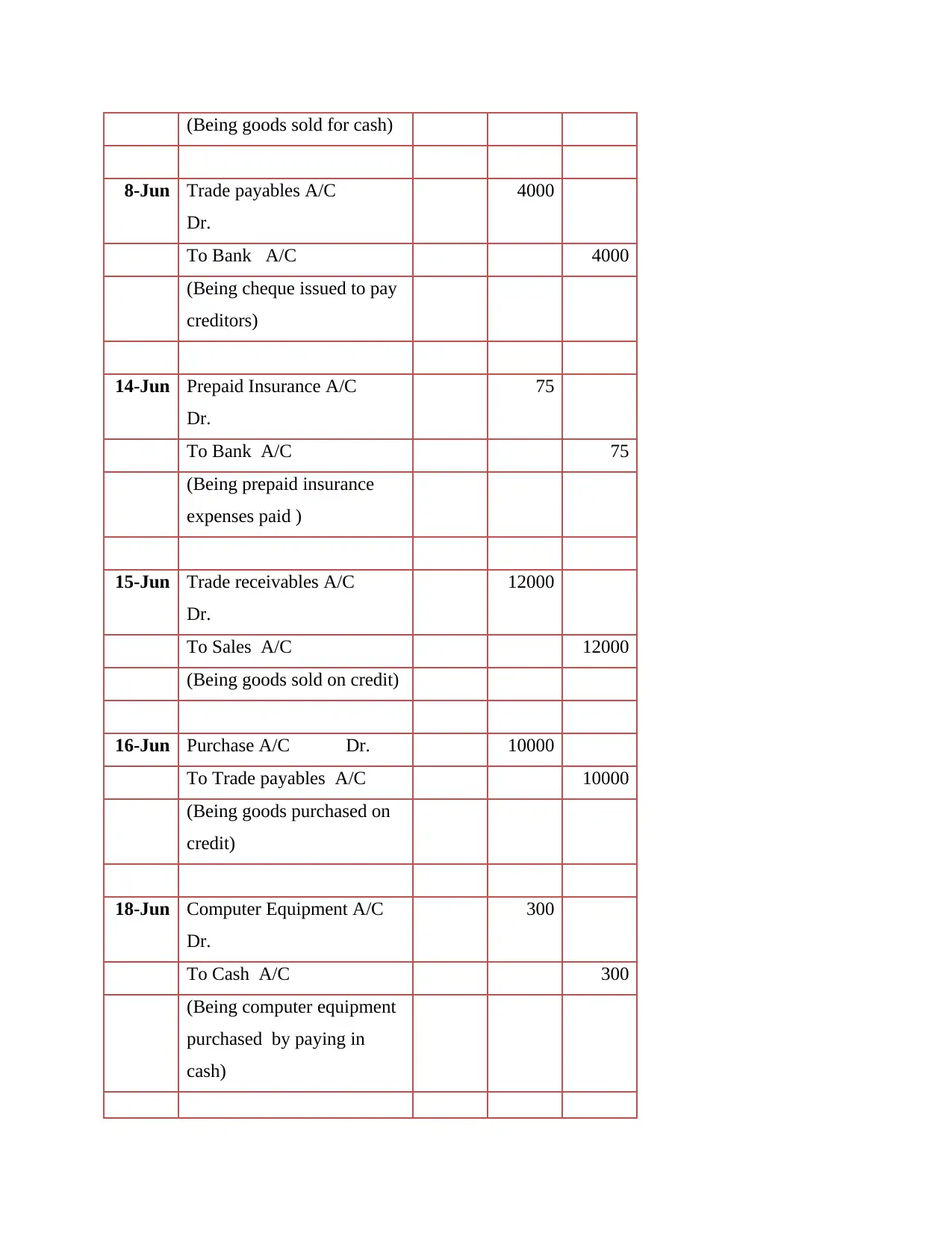
(Being goods sold for cash)
8-Jun Trade payables A/C
Dr.
4000
To Bank A/C 4000
(Being cheque issued to pay
creditors)
14-Jun Prepaid Insurance A/C
Dr.
75
To Bank A/C 75
(Being prepaid insurance
expenses paid )
15-Jun Trade receivables A/C
Dr.
12000
To Sales A/C 12000
(Being goods sold on credit)
16-Jun Purchase A/C Dr. 10000
To Trade payables A/C 10000
(Being goods purchased on
credit)
18-Jun Computer Equipment A/C
Dr.
300
To Cash A/C 300
(Being computer equipment
purchased by paying in
cash)
8-Jun Trade payables A/C
Dr.
4000
To Bank A/C 4000
(Being cheque issued to pay
creditors)
14-Jun Prepaid Insurance A/C
Dr.
75
To Bank A/C 75
(Being prepaid insurance
expenses paid )
15-Jun Trade receivables A/C
Dr.
12000
To Sales A/C 12000
(Being goods sold on credit)
16-Jun Purchase A/C Dr. 10000
To Trade payables A/C 10000
(Being goods purchased on
credit)
18-Jun Computer Equipment A/C
Dr.
300
To Cash A/C 300
(Being computer equipment
purchased by paying in
cash)
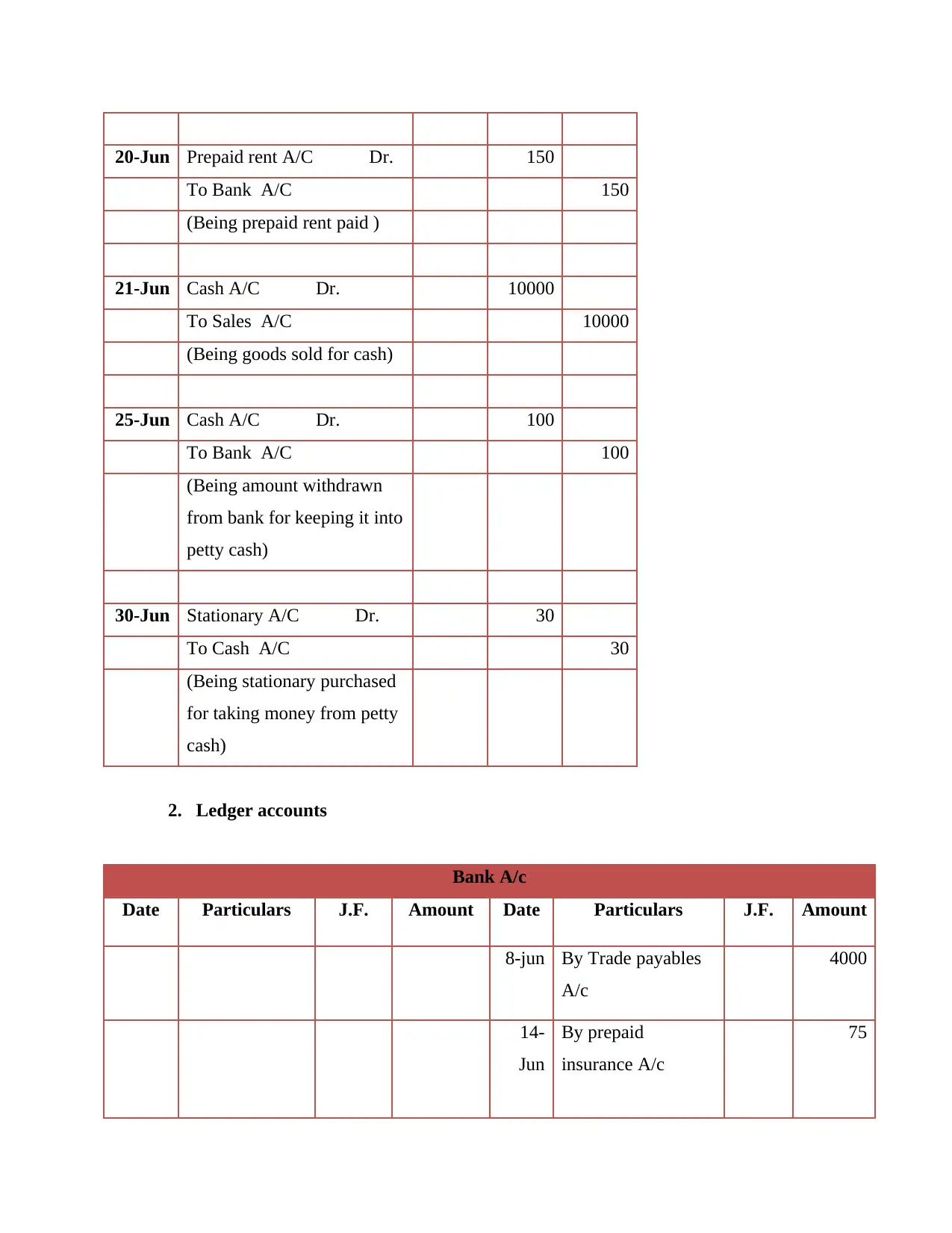
20-Jun Prepaid rent A/C Dr. 150
To Bank A/C 150
(Being prepaid rent paid )
21-Jun Cash A/C Dr. 10000
To Sales A/C 10000
(Being goods sold for cash)
25-Jun Cash A/C Dr. 100
To Bank A/C 100
(Being amount withdrawn
from bank for keeping it into
petty cash)
30-Jun Stationary A/C Dr. 30
To Cash A/C 30
(Being stationary purchased
for taking money from petty
cash)
2. Ledger accounts
Bank A/c
Date Particulars J.F. Amount Date Particulars J.F. Amount
8-jun By Trade payables
A/c
4000
14-
Jun
By prepaid
insurance A/c
75
To Bank A/C 150
(Being prepaid rent paid )
21-Jun Cash A/C Dr. 10000
To Sales A/C 10000
(Being goods sold for cash)
25-Jun Cash A/C Dr. 100
To Bank A/C 100
(Being amount withdrawn
from bank for keeping it into
petty cash)
30-Jun Stationary A/C Dr. 30
To Cash A/C 30
(Being stationary purchased
for taking money from petty
cash)
2. Ledger accounts
Bank A/c
Date Particulars J.F. Amount Date Particulars J.F. Amount
8-jun By Trade payables
A/c
4000
14-
Jun
By prepaid
insurance A/c
75
⊘ This is a preview!⊘
Do you want full access?
Subscribe today to unlock all pages.

Trusted by 1+ million students worldwide
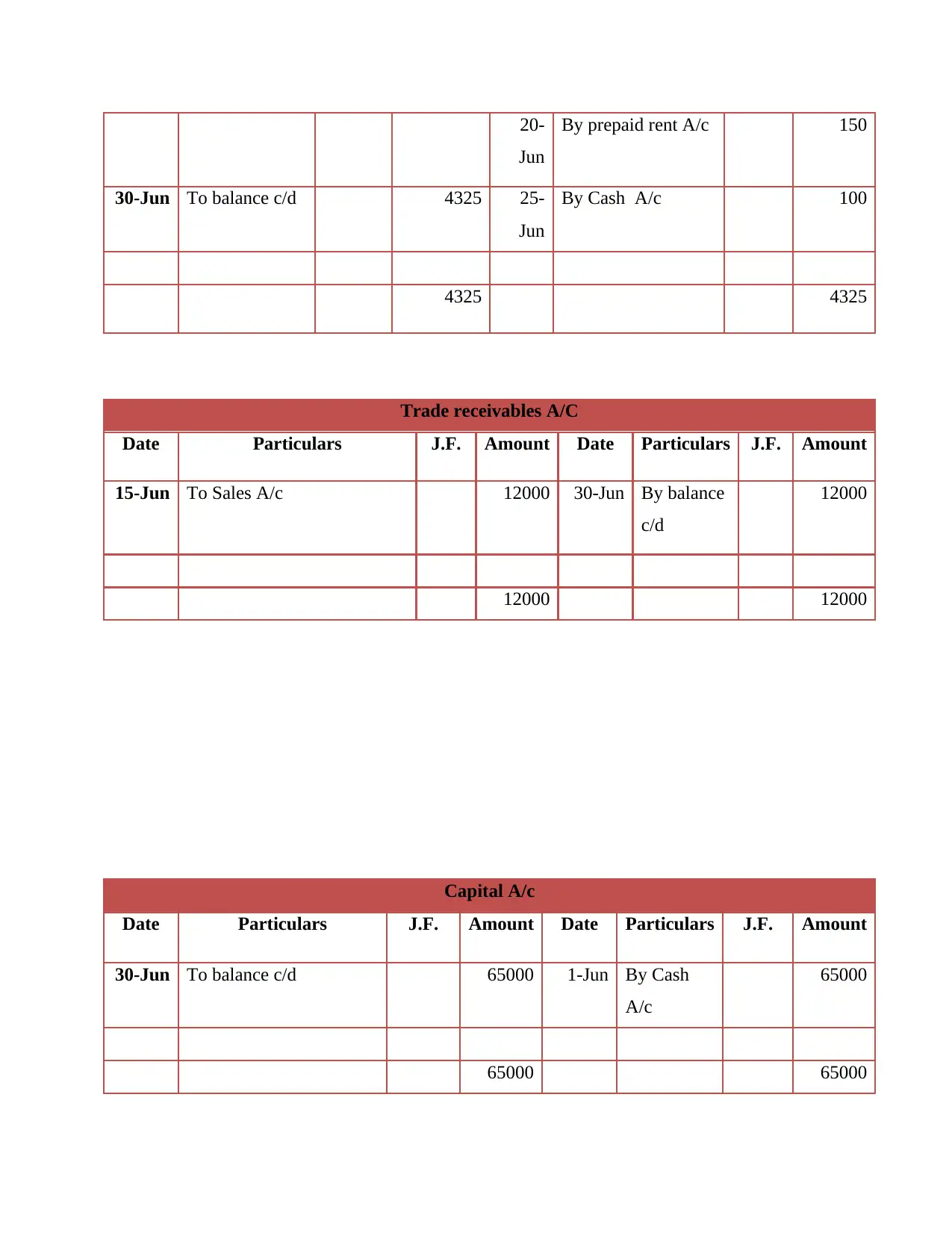
20-
Jun
By prepaid rent A/c 150
30-Jun To balance c/d 4325 25-
Jun
By Cash A/c 100
4325 4325
Trade receivables A/C
Date Particulars J.F. Amount Date Particulars J.F. Amount
15-Jun To Sales A/c 12000 30-Jun By balance
c/d
12000
12000 12000
Capital A/c
Date Particulars J.F. Amount Date Particulars J.F. Amount
30-Jun To balance c/d 65000 1-Jun By Cash
A/c
65000
65000 65000
Jun
By prepaid rent A/c 150
30-Jun To balance c/d 4325 25-
Jun
By Cash A/c 100
4325 4325
Trade receivables A/C
Date Particulars J.F. Amount Date Particulars J.F. Amount
15-Jun To Sales A/c 12000 30-Jun By balance
c/d
12000
12000 12000
Capital A/c
Date Particulars J.F. Amount Date Particulars J.F. Amount
30-Jun To balance c/d 65000 1-Jun By Cash
A/c
65000
65000 65000
Paraphrase This Document
Need a fresh take? Get an instant paraphrase of this document with our AI Paraphraser
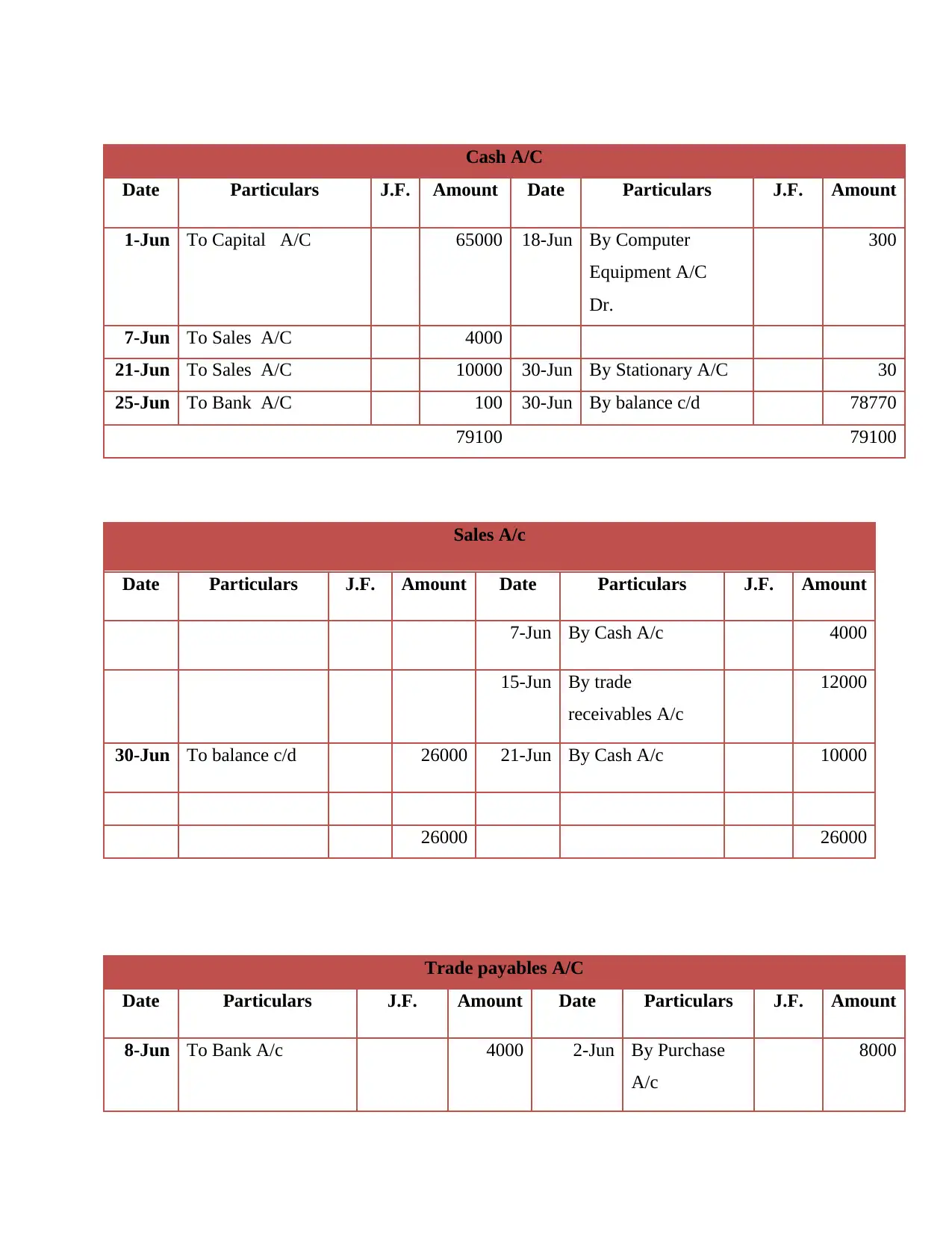
Cash A/C
Date Particulars J.F. Amount Date Particulars J.F. Amount
1-Jun To Capital A/C 65000 18-Jun By Computer
Equipment A/C
Dr.
300
7-Jun To Sales A/C 4000
21-Jun To Sales A/C 10000 30-Jun By Stationary A/C 30
25-Jun To Bank A/C 100 30-Jun By balance c/d 78770
79100 79100
Sales A/c
Date Particulars J.F. Amount Date Particulars J.F. Amount
7-Jun By Cash A/c 4000
15-Jun By trade
receivables A/c
12000
30-Jun To balance c/d 26000 21-Jun By Cash A/c 10000
26000 26000
Trade payables A/C
Date Particulars J.F. Amount Date Particulars J.F. Amount
8-Jun To Bank A/c 4000 2-Jun By Purchase
A/c
8000
Date Particulars J.F. Amount Date Particulars J.F. Amount
1-Jun To Capital A/C 65000 18-Jun By Computer
Equipment A/C
Dr.
300
7-Jun To Sales A/C 4000
21-Jun To Sales A/C 10000 30-Jun By Stationary A/C 30
25-Jun To Bank A/C 100 30-Jun By balance c/d 78770
79100 79100
Sales A/c
Date Particulars J.F. Amount Date Particulars J.F. Amount
7-Jun By Cash A/c 4000
15-Jun By trade
receivables A/c
12000
30-Jun To balance c/d 26000 21-Jun By Cash A/c 10000
26000 26000
Trade payables A/C
Date Particulars J.F. Amount Date Particulars J.F. Amount
8-Jun To Bank A/c 4000 2-Jun By Purchase
A/c
8000

30-Jun To balance c/d 14000 16-Jun By Purchase
A/c
10000
18000 18000
Purchase A/c
Date Particulars J.F. Amount Date Particulars J.F. Amount
2-Jun To trade payables A/c 8000
16-Jun To trade payables A/c 10000 30-Jun By balance
c/d
18000
18000 18000
Computer Equipment A/c
Date Particulars J.F. Amount Date Particulars J.F. Amount
18-Jun To Cash A/c 300 30-Jun By balance
c/d
300
300 300
A/c
10000
18000 18000
Purchase A/c
Date Particulars J.F. Amount Date Particulars J.F. Amount
2-Jun To trade payables A/c 8000
16-Jun To trade payables A/c 10000 30-Jun By balance
c/d
18000
18000 18000
Computer Equipment A/c
Date Particulars J.F. Amount Date Particulars J.F. Amount
18-Jun To Cash A/c 300 30-Jun By balance
c/d
300
300 300
⊘ This is a preview!⊘
Do you want full access?
Subscribe today to unlock all pages.

Trusted by 1+ million students worldwide
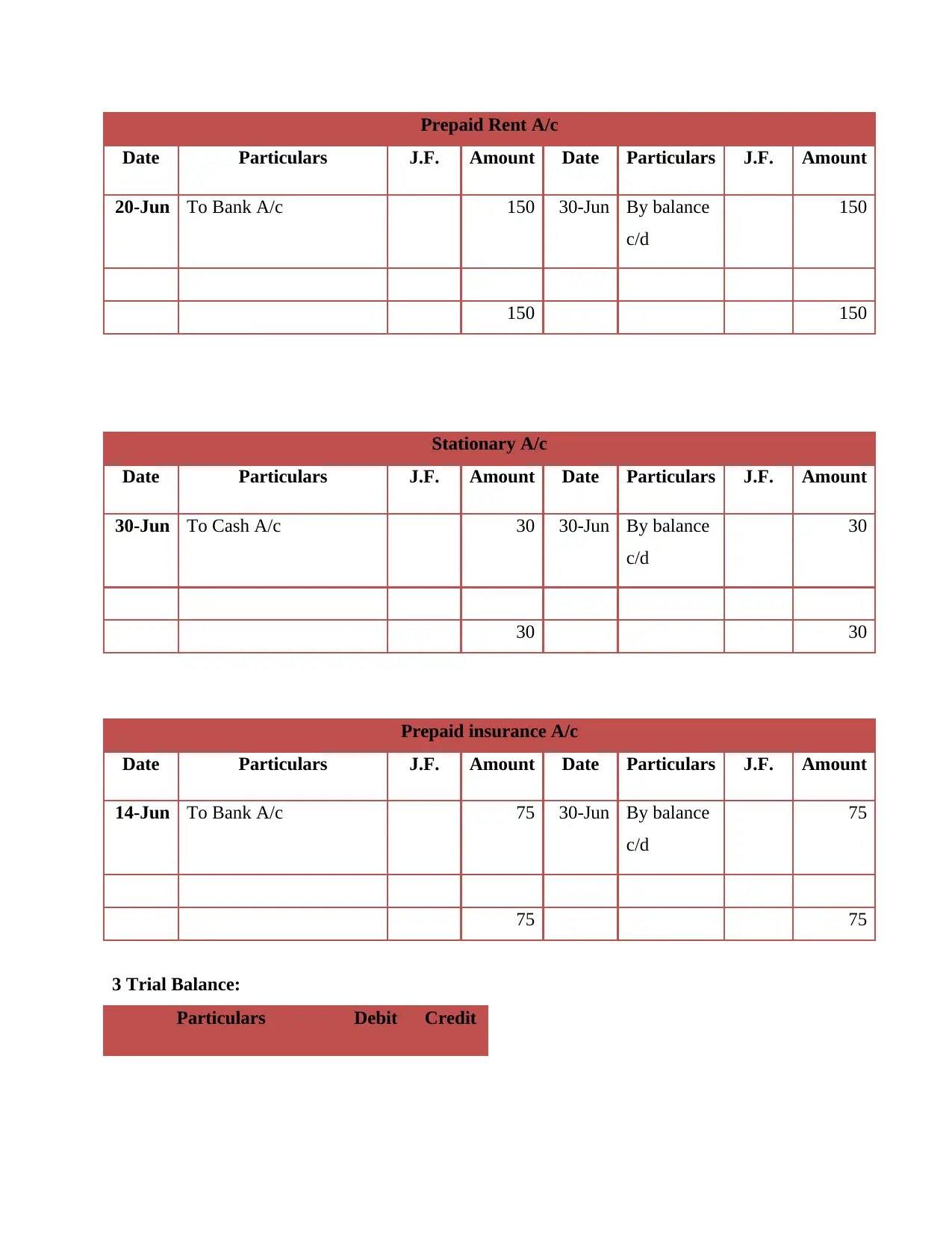
Prepaid Rent A/c
Date Particulars J.F. Amount Date Particulars J.F. Amount
20-Jun To Bank A/c 150 30-Jun By balance
c/d
150
150 150
Stationary A/c
Date Particulars J.F. Amount Date Particulars J.F. Amount
30-Jun To Cash A/c 30 30-Jun By balance
c/d
30
30 30
Prepaid insurance A/c
Date Particulars J.F. Amount Date Particulars J.F. Amount
14-Jun To Bank A/c 75 30-Jun By balance
c/d
75
75 75
3 Trial Balance:
Particulars Debit Credit
Date Particulars J.F. Amount Date Particulars J.F. Amount
20-Jun To Bank A/c 150 30-Jun By balance
c/d
150
150 150
Stationary A/c
Date Particulars J.F. Amount Date Particulars J.F. Amount
30-Jun To Cash A/c 30 30-Jun By balance
c/d
30
30 30
Prepaid insurance A/c
Date Particulars J.F. Amount Date Particulars J.F. Amount
14-Jun To Bank A/c 75 30-Jun By balance
c/d
75
75 75
3 Trial Balance:
Particulars Debit Credit
Paraphrase This Document
Need a fresh take? Get an instant paraphrase of this document with our AI Paraphraser
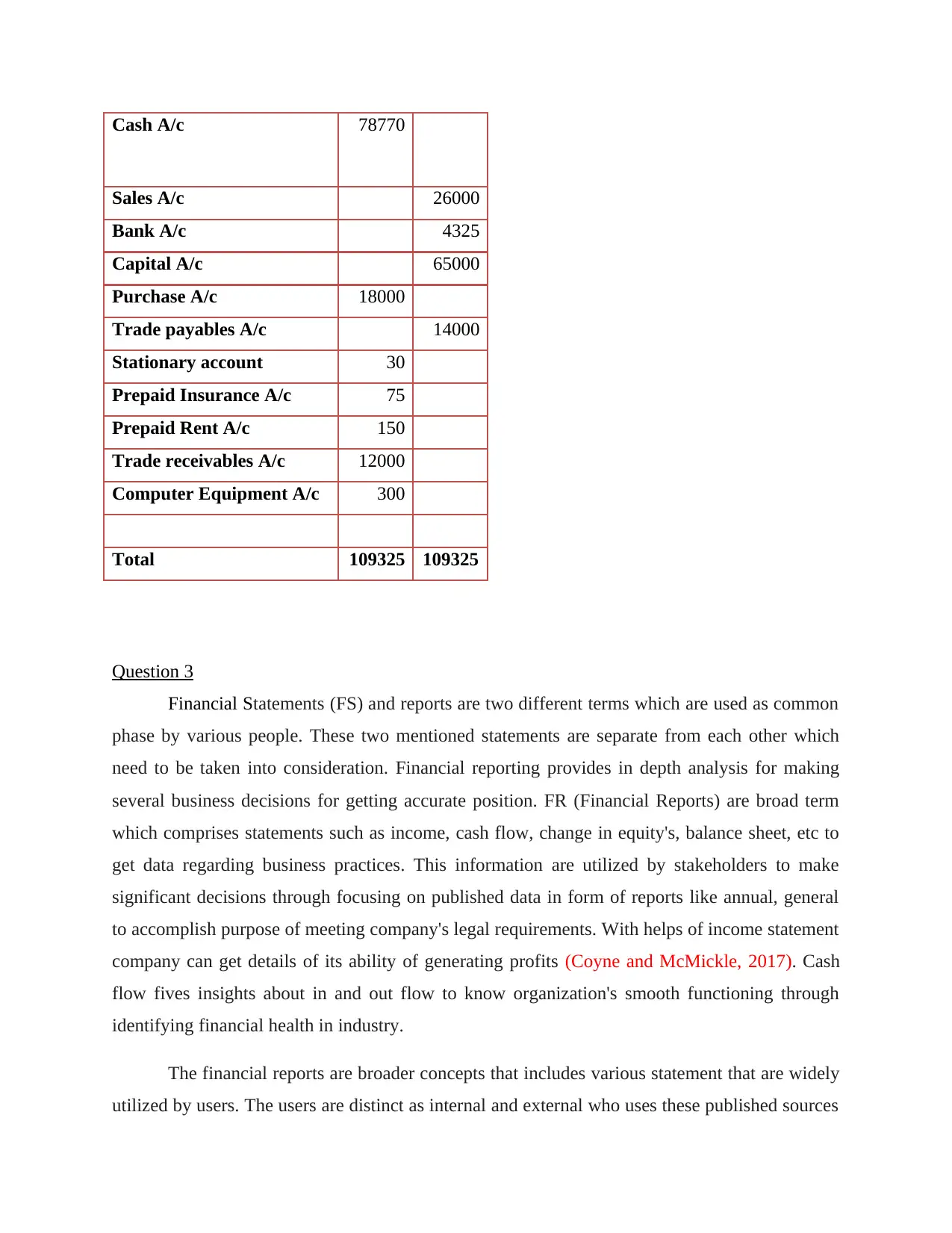
Cash A/c 78770
Sales A/c 26000
Bank A/c 4325
Capital A/c 65000
Purchase A/c 18000
Trade payables A/c 14000
Stationary account 30
Prepaid Insurance A/c 75
Prepaid Rent A/c 150
Trade receivables A/c 12000
Computer Equipment A/c 300
Total 109325 109325
Question 3
Financial Statements (FS) and reports are two different terms which are used as common
phase by various people. These two mentioned statements are separate from each other which
need to be taken into consideration. Financial reporting provides in depth analysis for making
several business decisions for getting accurate position. FR (Financial Reports) are broad term
which comprises statements such as income, cash flow, change in equity's, balance sheet, etc to
get data regarding business practices. This information are utilized by stakeholders to make
significant decisions through focusing on published data in form of reports like annual, general
to accomplish purpose of meeting company's legal requirements. With helps of income statement
company can get details of its ability of generating profits (Coyne and McMickle, 2017). Cash
flow fives insights about in and out flow to know organization's smooth functioning through
identifying financial health in industry.
The financial reports are broader concepts that includes various statement that are widely
utilized by users. The users are distinct as internal and external who uses these published sources
Sales A/c 26000
Bank A/c 4325
Capital A/c 65000
Purchase A/c 18000
Trade payables A/c 14000
Stationary account 30
Prepaid Insurance A/c 75
Prepaid Rent A/c 150
Trade receivables A/c 12000
Computer Equipment A/c 300
Total 109325 109325
Question 3
Financial Statements (FS) and reports are two different terms which are used as common
phase by various people. These two mentioned statements are separate from each other which
need to be taken into consideration. Financial reporting provides in depth analysis for making
several business decisions for getting accurate position. FR (Financial Reports) are broad term
which comprises statements such as income, cash flow, change in equity's, balance sheet, etc to
get data regarding business practices. This information are utilized by stakeholders to make
significant decisions through focusing on published data in form of reports like annual, general
to accomplish purpose of meeting company's legal requirements. With helps of income statement
company can get details of its ability of generating profits (Coyne and McMickle, 2017). Cash
flow fives insights about in and out flow to know organization's smooth functioning through
identifying financial health in industry.
The financial reports are broader concepts that includes various statement that are widely
utilized by users. The users are distinct as internal and external who uses these published sources
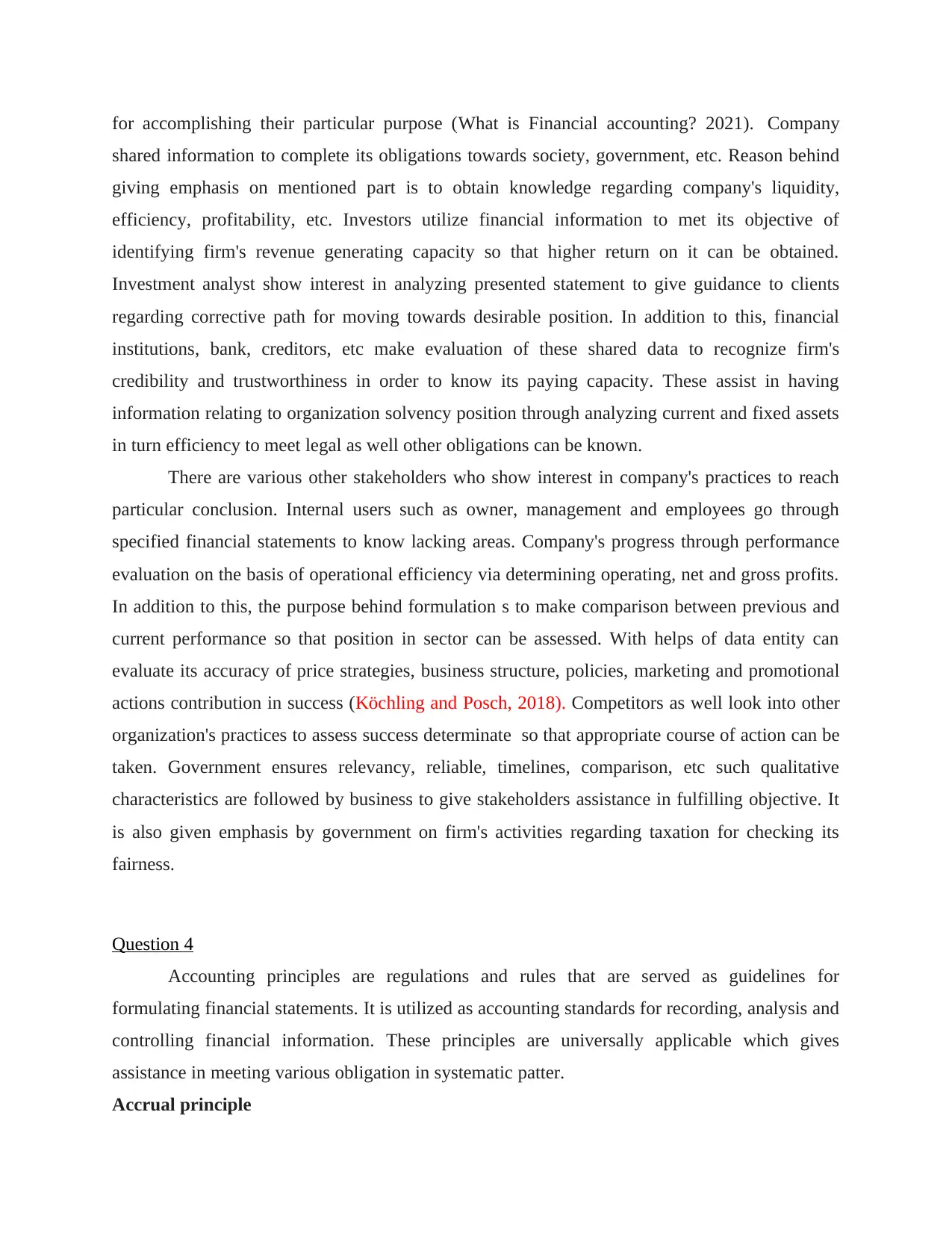
for accomplishing their particular purpose (What is Financial accounting? 2021). Company
shared information to complete its obligations towards society, government, etc. Reason behind
giving emphasis on mentioned part is to obtain knowledge regarding company's liquidity,
efficiency, profitability, etc. Investors utilize financial information to met its objective of
identifying firm's revenue generating capacity so that higher return on it can be obtained.
Investment analyst show interest in analyzing presented statement to give guidance to clients
regarding corrective path for moving towards desirable position. In addition to this, financial
institutions, bank, creditors, etc make evaluation of these shared data to recognize firm's
credibility and trustworthiness in order to know its paying capacity. These assist in having
information relating to organization solvency position through analyzing current and fixed assets
in turn efficiency to meet legal as well other obligations can be known.
There are various other stakeholders who show interest in company's practices to reach
particular conclusion. Internal users such as owner, management and employees go through
specified financial statements to know lacking areas. Company's progress through performance
evaluation on the basis of operational efficiency via determining operating, net and gross profits.
In addition to this, the purpose behind formulation s to make comparison between previous and
current performance so that position in sector can be assessed. With helps of data entity can
evaluate its accuracy of price strategies, business structure, policies, marketing and promotional
actions contribution in success (Köchling and Posch, 2018). Competitors as well look into other
organization's practices to assess success determinate so that appropriate course of action can be
taken. Government ensures relevancy, reliable, timelines, comparison, etc such qualitative
characteristics are followed by business to give stakeholders assistance in fulfilling objective. It
is also given emphasis by government on firm's activities regarding taxation for checking its
fairness.
Question 4
Accounting principles are regulations and rules that are served as guidelines for
formulating financial statements. It is utilized as accounting standards for recording, analysis and
controlling financial information. These principles are universally applicable which gives
assistance in meeting various obligation in systematic patter.
Accrual principle
shared information to complete its obligations towards society, government, etc. Reason behind
giving emphasis on mentioned part is to obtain knowledge regarding company's liquidity,
efficiency, profitability, etc. Investors utilize financial information to met its objective of
identifying firm's revenue generating capacity so that higher return on it can be obtained.
Investment analyst show interest in analyzing presented statement to give guidance to clients
regarding corrective path for moving towards desirable position. In addition to this, financial
institutions, bank, creditors, etc make evaluation of these shared data to recognize firm's
credibility and trustworthiness in order to know its paying capacity. These assist in having
information relating to organization solvency position through analyzing current and fixed assets
in turn efficiency to meet legal as well other obligations can be known.
There are various other stakeholders who show interest in company's practices to reach
particular conclusion. Internal users such as owner, management and employees go through
specified financial statements to know lacking areas. Company's progress through performance
evaluation on the basis of operational efficiency via determining operating, net and gross profits.
In addition to this, the purpose behind formulation s to make comparison between previous and
current performance so that position in sector can be assessed. With helps of data entity can
evaluate its accuracy of price strategies, business structure, policies, marketing and promotional
actions contribution in success (Köchling and Posch, 2018). Competitors as well look into other
organization's practices to assess success determinate so that appropriate course of action can be
taken. Government ensures relevancy, reliable, timelines, comparison, etc such qualitative
characteristics are followed by business to give stakeholders assistance in fulfilling objective. It
is also given emphasis by government on firm's activities regarding taxation for checking its
fairness.
Question 4
Accounting principles are regulations and rules that are served as guidelines for
formulating financial statements. It is utilized as accounting standards for recording, analysis and
controlling financial information. These principles are universally applicable which gives
assistance in meeting various obligation in systematic patter.
Accrual principle
⊘ This is a preview!⊘
Do you want full access?
Subscribe today to unlock all pages.

Trusted by 1+ million students worldwide
1 out of 26
Related Documents
Your All-in-One AI-Powered Toolkit for Academic Success.
+13062052269
info@desklib.com
Available 24*7 on WhatsApp / Email
![[object Object]](/_next/static/media/star-bottom.7253800d.svg)
Unlock your academic potential
Copyright © 2020–2025 A2Z Services. All Rights Reserved. Developed and managed by ZUCOL.





